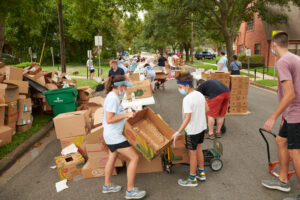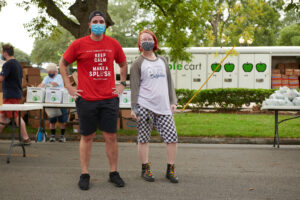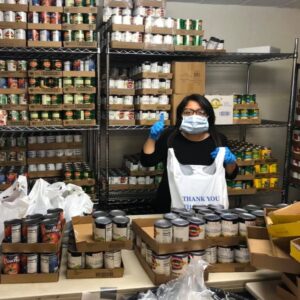Episcopal Church Women in the News 04-17-21
Summary
6KPVI TV – ‘Greatly blessed,’ still ‘coaching’: Retired Eutawville teacher sees much change in 100 years – Eliza Read Spiers Couturier, of Lawson’s Pond in the Cross community, turns 100…
Daily Telegram – COVID care packages contain items to help people through quarantine – would you have enough household supplies and food to avoid going to the store for fourteen days?…
Episcopal News Service – Meet the Episcopal priest moonlighting as a Mars rover mission scientist – From her living room in Maryland, Conrad connects virtually with scientists around the country and at NASA’s Jet Propulsion Laboratory in Southern California for several shifts a week, monitoring sensors that she helped design as they transmit data about the Martian environment
————–
‘Greatly blessed,’ still ‘coaching’: Retired Eutawville teacher sees much change in 100 years
6KPVI TV – Lawson’s Pond, ID
From coaching the Eutawville High School girls’ basketball team to decades of teaching and church involvement, Eliza Spiers Couturier has had experiences of a lifetime while enjoying small-town living.
“It’s something I didn’t think would ever happen. I’m amazed by it all and I feel greatly blessed,” said the soft-spoken Couturier from a rocking chair on the porch of her historic home, Lawson’s Pond, in the Cross community.
On April 16, she will turn 100.
“Most of my life, I have enjoyed good health,” she said. […]
COVID care packages contain items to help people through quarantine
Daily Telegram – Adrian, MI
If you were told today that you had to stay home for up to 14 days because you had tested positive for COVID-19 or were a close contact of someone with COVID, would you have enough household supplies and food to avoid going to a store?
A community initiative aims to help people who need a few things to get through a quarantine with COVID care packages. So far, about 40 care packages have been distributed, said the Rev. Dan Buchin of Christ Episcopal Church in Adrian. Christ Episcopal and City of Refuge Ministries International in Adrian are working with the Lenawee Community Foundation, Meijer of Adrian and the health department on the care packages. […]
Meet the Episcopal priest moonlighting as a Mars rover mission scientist
Episcopal News Service – Glen Burnie, MD
When Episcopal News Service recently spoke to the Rev. Pamela Conrad, rector of St. Alban’s Episcopal Church in Glen Burnie, Maryland, she was exhausted – but not only from the liturgical marathon of Holy Week or the weary slog of daily life during the COVID-19 pandemic. On top of that, Conrad is a member of the tactical operations team for NASA’s Mars rover mission, often working through the night, analyzing feedback from the Perseverance rover as it searches for signs of potential life.
From her living room in Maryland, Conrad connects virtually with scientists around the country and at NASA’s Jet Propulsion Laboratory in Southern California for several shifts a week, monitoring sensors that she helped design as they transmit data about the Martian environment. Among the instruments she works with are the cameras that have sent back over 25,000 photos, including Perseverance’s first selfie, which shows the rover and the small helicopter that is expected to take the first-ever powered flight on another planet later this week. […]

 Acerca del autor
Acerca del autor About the Author
About the Author It started with a little blessing box beside the church and has become a major ministry to the community, and it couldn’t have come at a better time. The blessing box evolved into a weekly Houston Food Bank distribution site. Then, in the middle of the third month of operations, the pandemic hit. At this time, the organizers pivoted to a drive-through distribution, which at its peak has been visited by over 400 families a week. The parish hall, previously used for Christian formation and fellowship, became a food storage warehouse for pallets upon pallets of non-perishable food items.
It started with a little blessing box beside the church and has become a major ministry to the community, and it couldn’t have come at a better time. The blessing box evolved into a weekly Houston Food Bank distribution site. Then, in the middle of the third month of operations, the pandemic hit. At this time, the organizers pivoted to a drive-through distribution, which at its peak has been visited by over 400 families a week. The parish hall, previously used for Christian formation and fellowship, became a food storage warehouse for pallets upon pallets of non-perishable food items. The drive-thru option allowed food to be given out in a safe way by the volunteers boxing up the food and then guests driving through the parking lot and the food delivered to their trunks. Some of these folks waited in the car line for up to two hours to get their food. It was calm and ordered, and all who received food were profoundly grateful.
The drive-thru option allowed food to be given out in a safe way by the volunteers boxing up the food and then guests driving through the parking lot and the food delivered to their trunks. Some of these folks waited in the car line for up to two hours to get their food. It was calm and ordered, and all who received food were profoundly grateful. My name is Monica Elias-Orellana. I was born in California and moved to Chelsea, Massachusetts, when I was 11 years old. It was then that I was introduced to the Episcopal Church, where I found myself embraced by God’s call to “serve thy neighbor.” I was taught early in life that I must help others even if I possess little.
My name is Monica Elias-Orellana. I was born in California and moved to Chelsea, Massachusetts, when I was 11 years old. It was then that I was introduced to the Episcopal Church, where I found myself embraced by God’s call to “serve thy neighbor.” I was taught early in life that I must help others even if I possess little. For me it is an honor to work with community members who, with love and dedication, serve families in need. My heart is full of joy and my eyes rejoice at seeing the beauty of local community members coming together to help one another. I have met incredible people who have worked many hours unloading boxes of food into the church, unpacking them, and distributing the food and other necessities given to the community. I admire that labor of love despite fears of exposure to the deadly virus. I am moved as I watch families come to the pantry for food and sometimes see tears and expressions of gratitude as they receive what they need to survive these difficult times.
For me it is an honor to work with community members who, with love and dedication, serve families in need. My heart is full of joy and my eyes rejoice at seeing the beauty of local community members coming together to help one another. I have met incredible people who have worked many hours unloading boxes of food into the church, unpacking them, and distributing the food and other necessities given to the community. I admire that labor of love despite fears of exposure to the deadly virus. I am moved as I watch families come to the pantry for food and sometimes see tears and expressions of gratitude as they receive what they need to survive these difficult times.